3D printing has long grown out of its initial rapid prototyping applications to become a fully-fledged manufacturing process. Known in the industry as additive manufacturing, it’s being used for producing an ever-widening array of things, from dental implants to jet engine parts. Indeed, it was only a matter of time before it reached the construction industry.
In simple terms, 3D printed houses are built by depositing material in a layer-by-layer manner. A paste-like concrete mixture is extruded through a nozzle that’s guided by an enormous gantry, creating walls from the ground up one layer at a time.
It doesn’t sound complex at first, and it really isn’t. The implications of such a construction process, however, are immense. Though still in its very early stages, it has already shown promising results and has rapidly caught the attention of the media.
The question is, is the hype around construction 3D printing really deserved? In this article, we’ll dive deep into the subject and show why we believe 3D printed houses might just be the next big thing.
Faster Construction
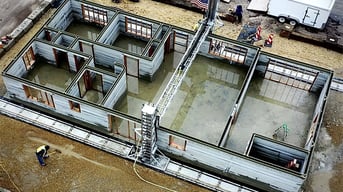
3D printing a house is significantly faster when compared to traditional construction methods. While the actual time frame relies largely on the project size, for most cases, construction takes only a matter of days.
Take, for example, the first fully-permitted 3D printed house in America, built by construction company Icon for the nonprofit New Story in 2018. The 350-square-foot house in Texas took around 47 hours of print time spread across several days.
Just two years later, another American company has built a massive 1,900-ft2 house in only 8 days, taking up to only 48 hours in total print time. Remember, however, that 3D printers can only create foundations and external and internal walls.
Still, according to SQ4D, the company responsible for the project, that’s a 40% reduction compared to regular construction techniques. While it might not seem much at first, construction 3D printing is still a developing technology that still has much to be perfected, so chances are construction times will reduce even further.
Reduced Labor
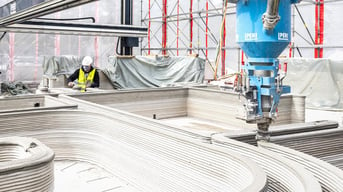
3D printing construction sites require fewer laborers than traditional sites, as the printing equipment does most of the work.
Generally speaking, traditional construction requires many steps, including a whole crew of nine-to-fivers unloading, transporting, and mixing materials before laying down structures. On the other hand, once set up, a concrete 3D printer only requires a handful of people to monitor and control its building process.

The aforementioned 1,900-ft2 house by SQ4D, for example, would require as few as 3 people on site, replacing a crew of over 20 manual laborers, according to the company. This goes to show how well-automated this entire process already is, and why 3D printing houses is such a promising alternative.
Moreover, fewer workers onsite also leads to fewer work-related injuries and fatalities. According to OSHA statistics, construction alone is responsible for one in five worker deaths in the US. If done responsibly, 3D printing houses can help reduce those numbers significantly.
Lower Costs
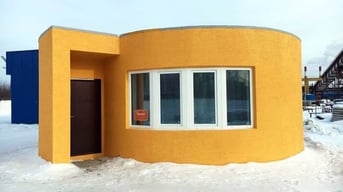
3D printed houses are reputedly cheaper to build, but this is somewhat debatable, as massive construction 3D printers are expensive equipment and do still present many limitations. But let’s keep it to facts and numbers.
We’ve already established that 3D printing a house is faster than traditional building, and as the saying goes, time is money. Less time spent on site means that both the equipment and the workers will be sooner available for other projects, having theoretically double the construction capacity with today’s figures.
Add that to the significantly reduced number of laborers required and the final spending should already be cut to a fraction of the original value. In addition, the raw materials used by some 3D printers can be partially gathered onsite, reducing costs associated with sourcing, storing, and transporting them to the site.
Now, to the numbers: Apis Cor‘s 410-ft2 house in Russia was said to cost approximately $10,000, including all windows, roofing, wiring, and interior finishing. That’s staggeringly low. Icon is currently working on 600-ft2 houses that are planned to cost as little as $4,000.
Yes, construction 3D printing equipment is still very expensive, just like any other cutting-edge piece of technology. There’s plenty of room for improvement and as the technology progresses, the costs associated with machinery and operation will surely reduce.
Unique Building Opportunities
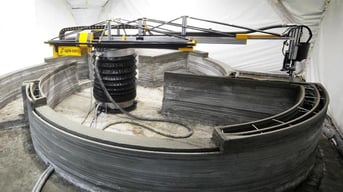
3D printing offers unique building opportunities that would be either impossible or too expensive to be created via conventional construction techniques.
Some say that, in order to get the best out of any 3D printing process, one must consider the high degree of design freedom provided by these technologies. This is also true for construction and architecture, where innovation and creativity are especially encouraged.
The intrinsic nature of 3D printing allows for complex shapes and forms to be produced without extra effort. For example, a concrete 3D printer can create intricately curved walls just easily as straight ones. Unconventional architecture can enhance how buildings look from the outside and even optimize internal spaces.
Take for example the “Office of the Future” in Dubai, 3D printed by Chinese company Winsun and which hosts the Dubai Futures Foundation. The curved-shaped exterior would require an excessive amount of work to be recreated using conventional building techniques.
Engineers can also get creative, as the printing feedstock materials can be highly customized to achieve better properties. Out of the batch, concrete is already a top-notch material for construction, resistant to most environmental agents such as fire and humidity, and also a great thermal insulator for cold and warm weather.
Higher Material Efficiency
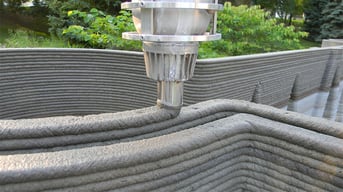
The process of 3D printing houses is more efficient in terms of energy and material usage when compared to traditional construction.
3D printing houses generate less waste as they use only the required amount of material to build structures: There are no offcuts from cutting or carving materials. Moreover, as the concrete-based feedstock materials are shapeless, any leftover can and should be used in the next building.
In addition, feedstock can be made out of recycled materials. Back in 2014, the Chinese company Winsun was able to build no less than 10 houses in one day using only recycled concrete material, whereas Italian 3D printing company WASP produced a house from natural mud mixed with waste materials from a local rice production, which included chopped straws and rice husks.
3D printing houses also take less energy when compared to the whole production chain of regular construction. Consider all the energy required from transporting raw materials and moving entire crews of workers to the construction site daily. By reducing the amount of labor and by sourcing materials onsite, 3D printing can be more sustainable in the long run.
Situational Applicability

Overall, 3D printing houses can play a central role in different scenarios worldwide. All the key points we’ve covered so far – reduced time, cost, labor, expanded unique opportunities, and efficiency – go to show how this technology can be of great value in certain situations.
Developing countries constantly struggle with housing issues. The ability to provide enough quality homes at affordable prices is key for sustainable economic development. The relatively quick process of 3D printing houses could potentially deal with homeless issues in the short term.
This exactly what New Story and Icon are trying to achieve in Tabasco, Mexico. The idea is to build the very first 3D printed community for local families currently living in extreme poverty. There will be a total of 50 entirely 3D printed 500-ft2 houses.
3D printed houses could also be beneficial in humanitarian crisis situations, especially after natural disasters where homes get tragically lost in earthquakes, fires, or tsunamis. The communities struck by such events end up struggling with labor and material shortage, not to mention logistical challenges. Rebuilding with 3D printing can pose an efficient and cheap solution to at least start these communities’ recovery.
And last, 3D printing could also make space exploration like Mars possible. The idea is to send automated 3D printing equipment to the red planet, and since the raw materials could be gathered locally, the printers could start building living spaces well before the first humans arrive. No wonder NASA is so interested in the technology.
Industry Shift & Investment

Construction 3D printing is getting more than just attention from industry leaders and investors: It’s taking their money, too!
The 3D printing market for construction has been consistently growing over the last years. In 2019, concrete 3D printer manufacturer COBOD reported profits in just its second year of operation, a huge accomplishment for any company and even more considering how raw this specific market still is.
Post-2020, the coronavirus crisis has impacted most industries worldwide, and construction 3D printing is no exception. It does, however, present itself as a fitting solution for such times, considering the reduced amount of onsite laborers. For this and other reasons, the global market for construction 3D printing is expected to grow from $4.4 million in 2019 to $114.4 million in 2023.
So, no need to take our word for it. Just remember that industry leaders are at the top because they understand the market, while big investors only put their money on feasible and truly promising technologies. 3D printed houses are the next big thing.
Global Spread
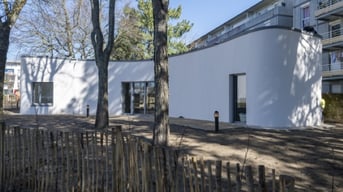
3D printed houses are already a reality, and it’s quickly spreading around the world.
While 3D printed houses are often seen in architectural competitions or as proof-of-concept designs, there are plenty of actual inhabited structures already in use. Take for example the Lewis Grand Hotel in the Philippines, with its 1,400-ft2 expansion made entirely with 3D printing, including bedrooms and living rooms.
Governments are also getting involved. In 2019, Russian company Apis Cor built the largest 3D printing building to date. The two-story 6,888-ft2 building is now home to the Dubai Municipality, being their second government 3D printed structure after the already mentioned Office of the Future.
In Europe, the 3D printed Yhnova House became one of the world’s first inhabited homes in 2018 when the Ramdani family moved in. The structure was developed by the University of Nantes using their own proprietary equipment, taking over 54 hours to 3D print the 1,000-ft2 structure.
Next time you hear about 3D printed houses, be reminded that although it’s still a developing technology, it has shown great results and is already in use around the globe.
Source: All 3DP




